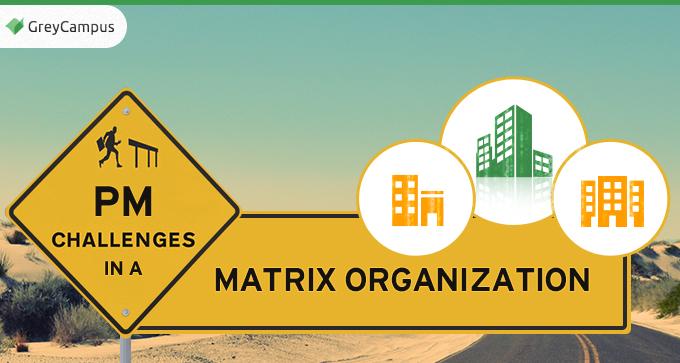PM challenges in a Matrix Organization
As a Project Manager, you can expect to face a number of challenges as you take on the responsibility of managing projects in your organization. However, the challenges increase many folds when you are managing a project in a purely functional organization – and in many cases, a matrix organization. In a matrix organization, all people who do one type of work are in a pool. For example, all engineers are a part of the engineering department and report to an engineering manager. These engineers may be assigned to different projects and report to a project manager while working on that project. However, being a project manager you won’t have much authority over these team members as they report to their functional managers. You should not expect to be granted very much formal authority because the functional managers maintain all authority over the project team members and the project budget. The gap between responsibility and authority is quite wide.
To make things worse, it is rare in functional organizations that project managers have direct input into team member performance evaluations, so given that these evaluations are solely performed by the functional managers, it is a reasonable assumption that team member loyalty would be with them and they’ll give priority to tasks assigned by them. So you will have to be prepared for the following situations:
- Team members’ availability changes without any warning from the functional manager.
- The allocation of team members changes frequently. Every now and then new hires are assigned to your project.
- Team members are substituted without prior notice to the project manager
- Project managers are cautioned from following up directly with team members on work status or progress
- Team members do not attend or have minimal interest in project status meetings
To help you in overcoming the different challenges of being a Project Manager of a matrix organization enlisted below are some measures you can take for what I consider four major challenges:
The challenge I - Conflicting goals:
One of the most difficult challenges occurs when people working on the same project have different goals. Conflicting goals stem from a lack of a shared vision for the larger picture. Understand that the functional managers may have different goals, objectives, and priorities, and these would have to be addressed in order to get the job done. Be ready to apply Covey’s Fifth Habit “Seek First to Understand, Then to be Understood”.
- Make sure your goals although different are aligned to the same vision as others you are working with.
- In times of conflict, communicate and discuss the difference in opinions before you start blaming each other.
- Develop the team in a manner that they understand, whether or not they all report to the same person, they are a team. If the team is not successful, none can be successful. Think “we” instead of “me.”
Challenge II - Shifting Loyalties:
When people assigned to your project are part of different teams and do not report to you directly, they do not see themselves as part of the same team. So if you try to exert power and control on them the attention is turned in the wrong direction. The conflict between functional managers and project manager erupts around prioritizing projects and allocating resources.
- To compensate for your perceived lack of formal authority, rely upon expert power (respect you can reap through superior knowledge or capability) or referent power (often accessed by practicing an excellent leadership style).
- Focus on the work to be done and the best way to accomplish it.
- Be ready to openly appreciate good work done by any of the project team members.
- Be there to support the project team member in time of crisis even if you are not his direct reporting manager.
- Develop personal relations with the team members so they see you as a friend and not as an authoritative jerk.
- For each major project or key responsibility area, create a Team Charter that clearly lists priorities, processes, decision-making processes, resources, etc.
- Rely heavily upon your ability to influence and persuade.
Challenge III – Unclear Roles and Responsibilities:
When the project team members are in different teams they may not be clear about whom to contact for information and/or fail to share important information with those who need it. Someone might be seen as dropping the ball when they never knew the ball was in their court.
- Set up a communication plan and share it with all the stakeholders.
- Maintain healthy communication and be willing to talk to each other to learn what hindrances they are facing in completing their tasks.
- Create a RACI chart. For each aspect of the project, identify what role each person plays: R= responsible to do the work and involved in decisions (several people). A= ultimately accountable for success (usually just one person, although it can be shared). C=consult to the project because they have needed information or expertise but do not make decisions or do the work. I=informed, people who are not directly involved but need to be updated on progress.
- Engage senior-level managers to enable functional managers to fill any gaps left by assignments to project work so that their work is not hampered.
Matrix organizations can be challenging to work in. To succeed, make sure that you're clear on your roles and priorities, and negotiate any conflicts or mismatches in these assertively.
